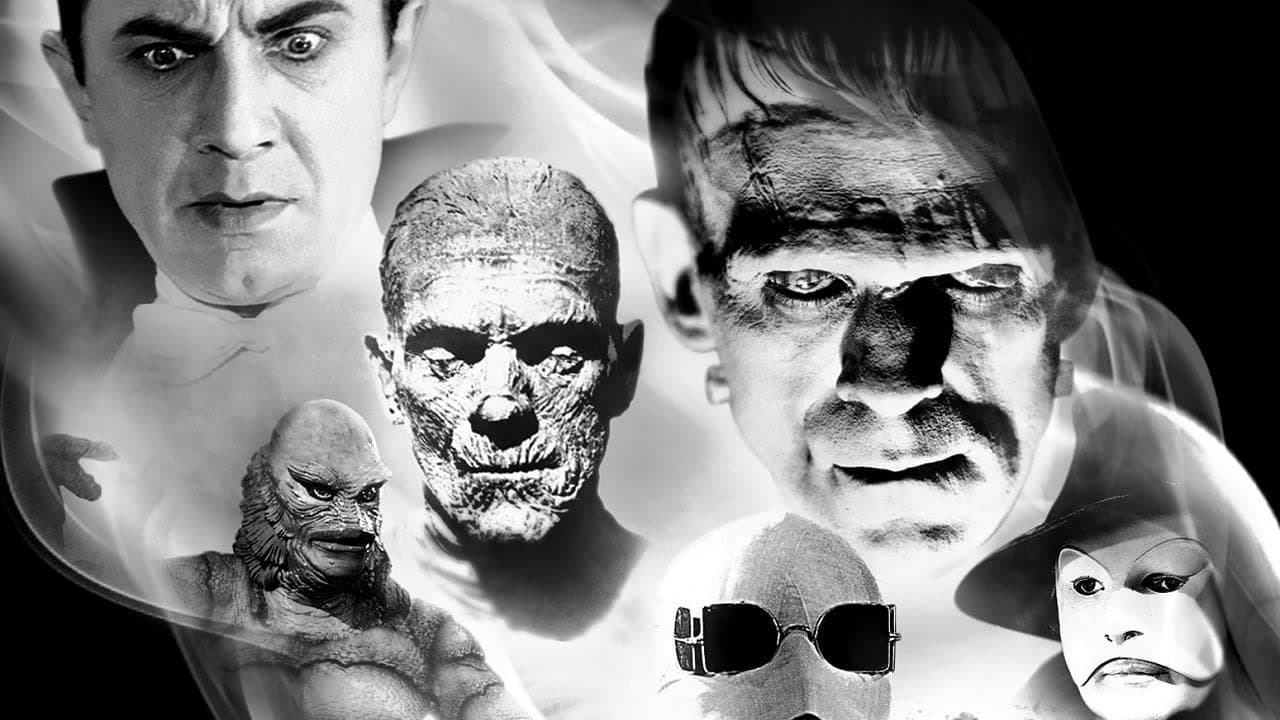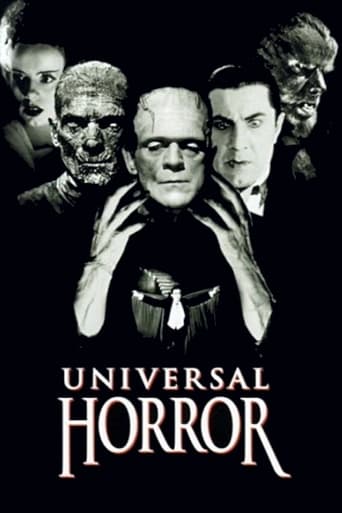

Wonderfully offbeat film!
... View MoreGood start, but then it gets ruined
... View MoreExcellent adaptation.
... View MoreThis is a tender, generous movie that likes its characters and presents them as real people, full of flaws and strengths.
... View MoreThis documentary about the unique horror franchises that came out of Universal studios during the 20s and 30s, pretty much ending with the Wolfman in 1941, really is universal, in that the documentary makes ties from the Universal films to the German silents that were their forerunners, and even ties the Universal monsters to subliminal guilt some felt over WWI, embodied in its often deformed survivors. Maybe this guilt is one reason isolationism held the U.S. from entering WWII until it was almost too late? But I digress. The film analyzes in detail the Dracula, Frankenstein, Invisible Man, and Mummy franchises, and talks a little about the Wolfman. They entirely omit any discussion of Creature from the Black Lagoon, probably because that was the 50s, and after the nuclear bomb and the Nazis who is really afraid of a giant fish anyways? The documentary mentions that the production code and the loss of Universal by the Laemmles is what really ended the classic cycle of horror at Universal, because the new owners just never got the hang of making horror with the same insight into the public's subliminal fears like the films from the 20's through 1936 did.Commenters include author Ray Bradbury, who says he drew some of his inspiration from these films, and James Karen, giving his boyhood memories of seeing these films in the theater as a child. He had no ties to anybody at Universal, but just seems like someone who is young at heart. He is still with us and soon to be 94. Film critic David Skal gets annoyingly enthusiastic, but maybe horror is his passion. He is being shot in a room full of horror memorabilia, but, hey, maybe he has rooms in his house each dedicated to all different kinds of film including anime? Boris Karloff's daughter Sara, Gloria Stuart - once a Universal contract player, and Carla Laemlle also talk about their experience in and around the sets of these famous Universal horror films.Horror films from other studios are also mentioned such as Dr. Jekyll and Mr.Hyde as well as Mystery of the Wax Museum and King Kong.This film does a very thorough job of discussing Universal horror films in general, and ends with a bit of a mystery, almost sounding like a curse. Carl Laemmle Jr., head of Universal at the time the Laemmles went into bankruptcy, came down with an undiagnosable illness and lived the rest of his life as an invalid. A chilling end to a chilling and fascinating documentary.It only makes me wonder, how can a studio make such a great documentary filled with thorough understanding of their own film history, and then treat that film history so shabbily? Probably Paramount and Universal are the two worst studios about giving no care at all to their catalogue of classic films.
... View MoreThis is a great documentary chronicling all of the major Universal Horror releases from the 1930s, plus all of the major actors and directors of the period. It's obviously made by people with a great love of the genre, and the affection shines through at every moment. The documentary consists of a number of people sharing anecdotes (it's surprising how many of the actresses - Gloria Stuart, Fay Wray, etc. are still alive) interspersed with loads of clips from the best bits of the films. About half of the stories I had heard already through general reading, but there are a wealth of lesser known snippets among them too.While the film clips highlight all the expected best bits from things like Dracula, FRANKENSTEIN, THE BRIDE OF FRANKENSTEIN, and THE WOLF MAN, there are also a number of lesser-seen moments too. For example we get to see test footage of a green Frankenstein monster, plus many clips from a lot of rare silent films starring Lon Chaney from the 1920s which are great to watch. Other, less talked-about films are discussed like THE BLACK CAT and THE RAVEN. Author David J. Skal pops up to talk about his love of the films, along with actor James Karen, author Ray Bradbury, Sara Karloff, Forrest J. Ackerman, and scriptwriter Curt Siodmak. UNIVERSAL HORROR is a reverential documentary which has been put together nicely, never outstays its welcome, and really makes you appreciate all those old horror films.
... View More. . . jotted down 22 pages of notes about it (in the ball park of how many GONE WITH THE WIND would merit). The primary commentators for this 1998 feature-length documentary running 95 minutes, 22.13 seconds are sci-fi author Ray Bradbury, POLTERGEIST actor James Karon, film historian David Skal, TITANIC actress Gloria Stuart, KING KONG actress Fay Wray, and film historian George Turner. 1931 Dracula cast member Carla Laemmle, niece of Universal Studio's founder Carl Laemmle, makes an appearance, along with Karloff's daughter, Sara, and "Eva" from the 1931 Spanish version of Dracula, Lupita Tovar. Three dozen classic horror films are referred to, with clips included from most. Some of these still available flicks are not even from Universal, such as THE OLD DARK HOUSE (1932). This is a good resource for young people whose horror knowledge may begin with Freddy, Jason, and Michael--or, heaven forbid, with Jigsaw! It can teach them the A, B, C's of early horror, such as the original Fab Four: Dracula, Frankenstein's Monster, The Mummy, and The Wolf Man. Every film buff needs to see this feature at least once.
... View MoreThis is really one of the better horror movie compilation/documentaries out there. A big reason for that is because of it's subject: Universal Pictures. This is the studio that produced the definitive versions of such films as Dracula, The Invisible Man, Frankenstein, The Wolfman and on and on. This documentary is interesting as it traces influences on these movies. It brings out that facial disfigurement in the movies was perhaps a reflection of veterans of World War I coming home with injuries from war, the idea of evil in ordinary looking people who were truly monsters was a reflection of the normal looking men who were otherwise nazi monsters. Traces origins in movies of the most famous Universal characters, showing clips from silent movies and also tracing the careers of various directors and the Laemmles who were in charge of Universal. People who were in these movies are interviewed and also, as a treat for the horror fan, well known personages in the Horror fan community such as Forrest Ackerman and others are interviewed and they share their earliest memories of seeing Universal films. Recommended to the horror fan. If you are new to classic horror films of the 1920s through the 40s, this would be a great education and shows you the most important and influential films to track down.
... View More